Notre Dame entered the final game of the 2018 season having allowed an opponent to go over an average (40%) success rate just once, against Michigan. The Trojans put up a 50% efficiency mark, besting the Irish by 12%. How did Notre Dame overcome this disadvantage, and what areas still need to be cleaned up moving into the postseason?
Confused? Check out the advanced stats glossary here or holler at me in the comments. No garbage time in this game, but as always sacks are counted in pass plays and yardage and kneel downs are excluded.
Efficiency
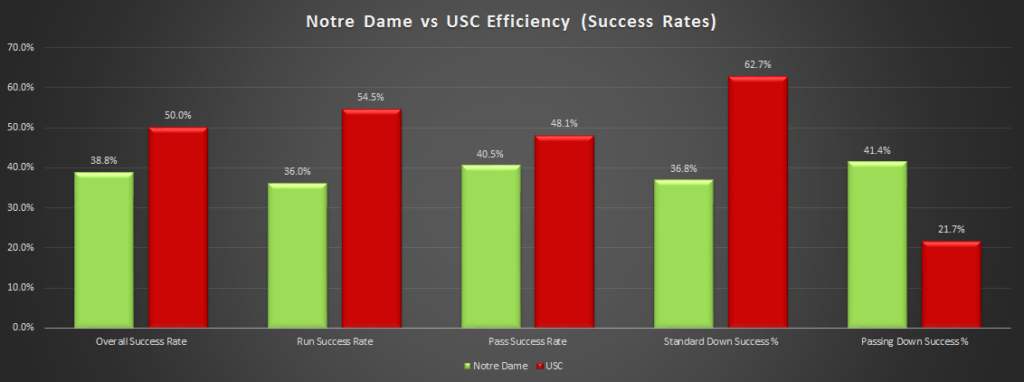
Notre Dame had allowed just one opponent (Michigan) to post a success rate above 40% (national average) this season, but allowed a 50% mark against the Trojans. JT Daniels and the Trojan receivers were incredibly efficient in the first half, converting 12 of the first 16 pass attempts into successful plays and bending then breaking the Irish defense early. Two timely forced fumbles and ND recoveries blunted the damage, but the 60% first half success rate and 7.58 yards per play allowed were both season worsts by the defense by a significant margin.
Thankfully second half adjustments once again came through for Clark Lea and the Irish defense. USC mustered just 4.28 YPP after halftime, and had successful plays on just one of their 13 pass plays after halftime. The ND pass rush came through when it needed to the most, and despite pretty good run efficiency in the game (55% success rate, 5.09 yards per run) Clay Helton never really committed to the run game, with just 22 run plays to 52 drop backs.
It was also the second-worst efficiency performance by the Irish offense (second again to the opener versus the Wolverines). Ian Book and the offense started slow, taking advantage of Chris Finke slipping open routinely in the first half but bogging down in the run game and a few times struggling with pressure and reads.
With a lot of negative plays the Irish offense faced a lot of second and third down and longs, with a season-high 29 passing downs. Thankfully Book was pretty excellent on these plays, with a success rate on passing downs (41.4%) that actually was better than on standard downs (36.8%). That shouldn’t happen, and is proof of both the early down struggles and 3rd and long excellence, highlighted by a couple of gritty Book scrambles. I would not recommend an average 3rd down distance of 9.7 yards but if you have to, having a QB that can guide you to converting 43% of those is a luxury.
Explosiveness
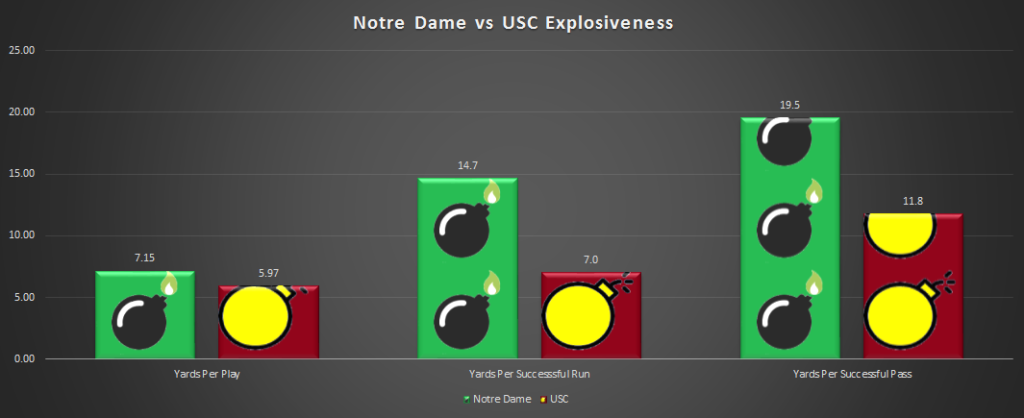
With the offense struggling to match its usual efficiency and an aggressive USC scheme, it took a strong explosiveness edge to propel Notre Dame to this win. While you’d prefer not to rely on Troy Pride and Alohi Gillman making awesome plays, it worked to keep things close in the first half while the Trojans stormed out the gate. Before the final Notre Dame drive of the half, where with some subpar clock management and a short Hail Mary the Irish came away empty, USC was outgaining the Irish by a horrific 3.23 yards per play.
You could argue that those were empty yards since it resulted in no points, but it closed the YPP gap to -1.4 and seemed to provide some important confidence for the passing game heading into the break. Most importantly, it ensured the Irish won the total yardage battle in this game, avoiding the devastation of being 12-0 but just 9-3 in Total Yards Championship Belts™ with losses to rivals Michigan and USC (and Vanderbilt) in that category.
The second half was the opposite, with Notre Dame outgaining the Trojans 8.15 YPP to 4.28. Many of USC’s yards late in the game also came on a late drive where the Irish defense was more worried about the clock than all-out preventing a score in a two-possession game. The blitzes that had been so effective for the Trojans initially were quickly countered with some inspired play calling by Chip Long.
In the end, Notre Dame overcame a significant efficiency gap with those chunk plays, landing 7 gains of 20 yards or more, including the two 50+ yard scores in the second half that were the biggest plays of the game. The Irish defense continued their trademark big play prevention, allowing just three plays of more than 20 yards despite 37 successful plays given up.
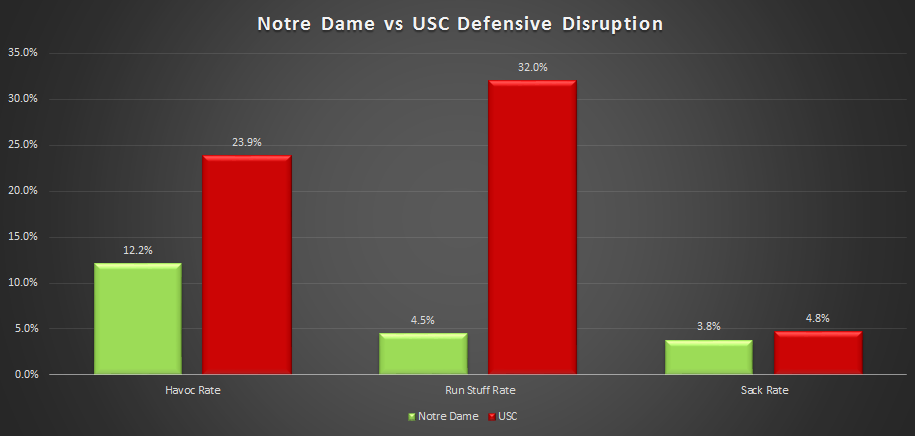
While I didn’t get to the advanced stats review of Syracuse last week, lost in a very strong performance were a couple of red flag areas that traveled with the team to Los Angeles. One was converting scoring opportunities (scroll down for that later), the other was run stuffs.
Against a bad Orange defense the Irish were stuffed for no gain or a loss on a whopping 36% of their carries before garbage time. In the Coliseum against a more talented but pretty mediocre Trojan run defense, it was again a far too common occurrence for an Irish runner to be stopped at or before the line, with a 32% run stuff rate.
That makes three of the last four games with opponent run stuff rates at about 30% or greater, far above the national average allowed of around 20%. Some of this is opponent scheme and what they’ve been willing to give up, but having this many runs that gain nothing means you have to be really freaking explosive or good on passing downs to overcome it. Thankfully in this one the Irish were both, but it’s high on the list of concerns against a postseason opponent that figures to be better at stuffing the run than Northwestern, Syracuse, or USC.
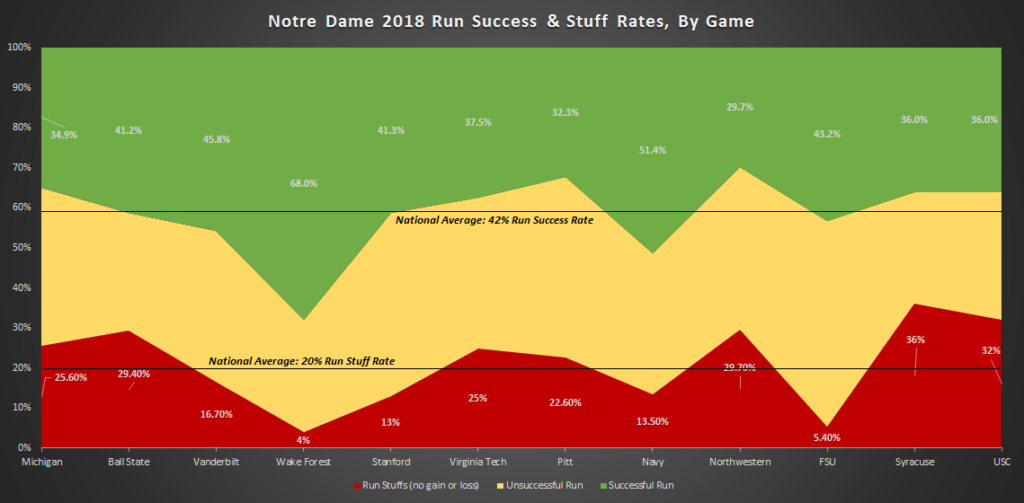
For the Irish defense, the run stuff and sack rates didn’t stand out, and qualitatively the excellent front seven looks like it will benefit tremendously from a month of rest and recovery. There haven’t been many tackles of a loss against opposing running backs over the last few games, but some of that seems to be by design (both bend but don’t break and also daring opponents that struggle to run to do so enough to hurt the ND defense).
Finishing Drives, Field Position, & Turnovers
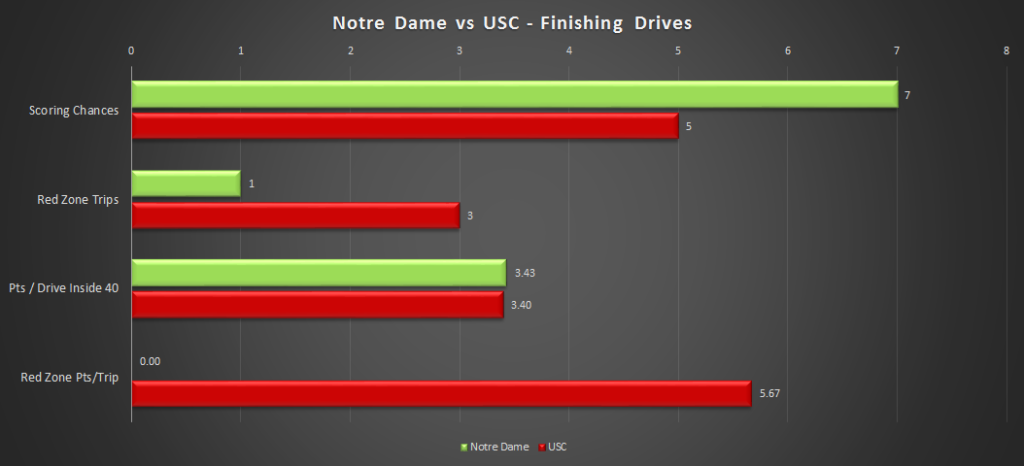
Coming off the win over Syracuse last week a common takeaway was that it easily could have been an even bigger Irish win. With Book back at QB, the Irish offense made seven visits to the red zone, where they had been pretty strong this season, averaging 5.35 points per trip. But in Yankee Stadium they stumbled close to the end zone, settling for three field goals and turning it over on an ill-advised Book fadeaway at the goal line.
Against USC it was a variation of the same theme. With touchdowns coming off of explosive plays from outside the red zone, the Notre Dame offense technically had just one red zone visit, and that possession also ended in a bad Book decision and interception (he had no red zone turnovers before the last two games). The Irish had two other trips inside the USC 40 come away with zero points – the short Hail Mary possession and a 3rd quarter possession where the offense stalled and punted on 4th and 10 from the USC 36 (and ended up with 16 yards of field position to show for it, boo).
Thankfully the Trojans were similarly limited converting their scoring chances, with the forced fumbles and penalties playing a key role in ending several USC drives.
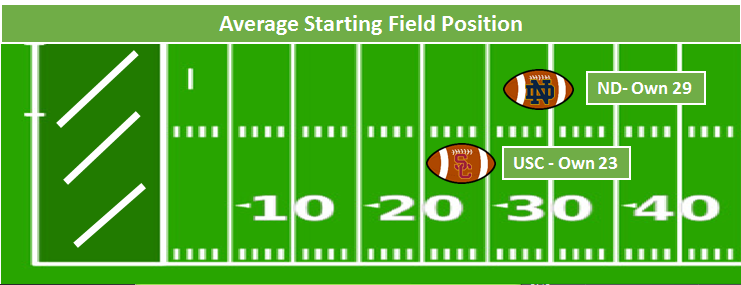
Notre Dame special teams were quietly very good in this game, with the much-maligned kickoff and coverage teams doing a nice job. Tyler Newsome couldn’t pin the Trojans deep in their own end on the punt mentioned earlier, but did boom a clutch 59-yarder in the first half to flip the field when nothing else was going well. Justin Yoon’s field goal make was enormous, and I’m truly in denial that someone else will ever kick field goals for this team.
The Irish technically benefited from a small amount of turnover luck in this game, but when you rip the ball out of a guy’s arms and then go jump on it I think the statistical 50/50 thing kinda goes out the window. The lone ND turnover hopefully goes into the mental file folder of “never again” for Ian Book, who I’m sure in a lot of situations rightfully has a lot of confidence throwing up a jump ball for his very large receivers. I’ve also come to accept that about once again he will not see an end dropping into coverage and keep saying Hail Mary’s that those passes are not thrown or not caught.
12-0
Before the season, I wrote that the ceiling for this team was a top-5 defense (if it could become more disruptive) and a top-20 offense, although it was unlikely both would happen unless the offense became less one-dimensional. Well, the Irish offense certainly gained a passing attack, and the defense has been exceptional in Clark Lea’s first year. Imagine telling a fellow Notre Dame fan when Mike Elko left last offseason not to worry, because the answer was on staff and that this would be one of the best defenses in the nation next season?
The ceiling has been met and then some, with the defense currently 3rd in Defensive S&P+ and the offense checking in at 28th, and obviously better than that in the games with Book starting. The schedule surely broke in nice directions for the Irish, and clutch plays and the defense clinched some early wins when pieces were not firing on all cylinders. There is an alternate universe where this team is in a playoff debate at 11-1 with the one loss to Vanderbilt and it would have made this coming weekend 10,000 times less enjoyable.
This team will join an exclusive club in making the playoff, and this wasn’t a cheap one. The Irish are deserving, a top 5 quality team, and took advantage of the breaks that went their way. In contrast Michigan will have fielded a top 5-10 quality team in three of Harbaugh’s first four years and have all of a second place finish in the B1G East to show for it. This team showed up on all of the biggest stages, consistently played excellent defense, and made tough changes when needed. National pundits were falling all over themselves to pick this team to lose at Wake Forest, and Brian Kelly and the coaching staff sought continuous improvement through each win, knowing the upside of this team.
That’s always been the formula – be good enough, and by that I mean top-10 and preferably top-5 quality, and hope things break your way. Last year’s team was in the playoff conversation well into November but wasn’t quite good enough. 2015’s team was probably good enough (at least as good as the MSU team that made it and probably a few others) but the breaks didn’t go the right way.
The 2018 team is probably the most talented and complete team of the bunch, and while they won’t be favored against the top two teams, it’s a chance to prove themselves against the best in the business, and I dare you to go tell Drue Tranquill, Dexter Williams, or Alohi Gillman that they should be worried about playing Bama or Clemson.
Finally, if you have any questions on the season as a whole I’ll be looking at some regular season analysis and initial breakdowns of Notre Dame’s playoff opponent over the coming weeks. Drop any questions in the comments section and I’ll answer the easy ones there or weave them into future posts as we gear up for a tremendously fun holiday season of football.

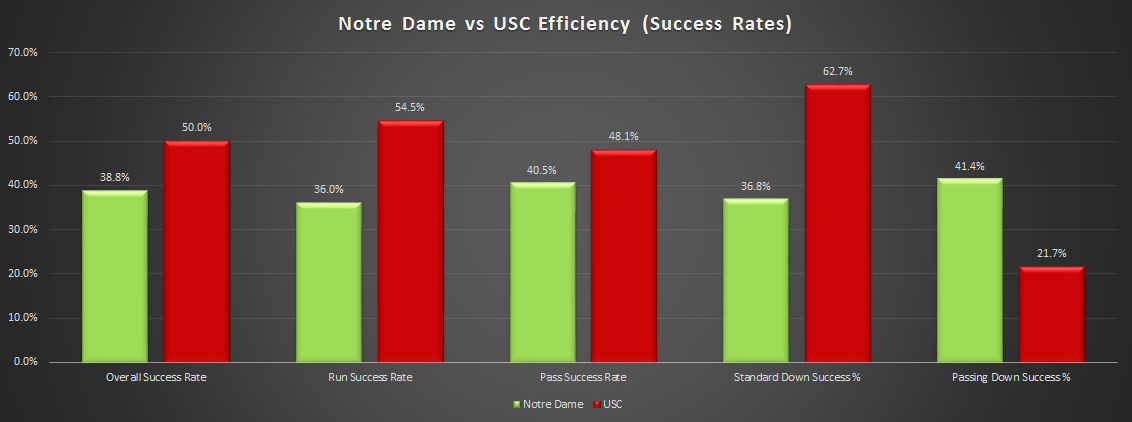



Wow, Michael. This column is up at the top pf your excellent columns. Most informative, and more than a bit concerning. I am sure we will get better over the next few weeks, but so will the other guys. But I do love our heart and solid tenacity. Need advanced stats for those!
There’s definitely concerns. The first half was up there for worst of the season along with the first against Pitt and the first against Northwestern. I’d argue it was worse than those two because at least in those games the defense had one bad / kind of fluky touchdown drive given up but mostly locked down the other team.
That said, the second half was pretty dominant, and big picture the advanced stats didn’t ding us much for the effort. I don’t think there’s anything USC did early on that a future playoff opponent will suddenly go “Aha!” and emulate that a previous opponent hadn’t. And while every team will get healthier over the next few weeks 1) I think it may help us more than some other playoff teams, because we need to have as close to peak Book, Kareem, Tranquill, etc as possible and 2) they have an extra game to play this week where who knows what could happen with wear and tear and injuries in conference title games.
I agree, great piece Michael.
>The ceiling has been met and then some, with the defense currently 3rd in Defensive S&P+ and the offense checking in at 28th, and obviously better than that in the games with Book starting.
On this week’s Sunday S&P+ podcast, Connelly stated that if you took the Book-only games for ND, we’d move from 6th up to 4th in total S&P+. That’s something to be pleased with.
Is there anyway we parlay this into a huge surge in recruiting? I know we barely have any spots left, but it would be nice if we could get a class similar to that one from the 2012 season.
Come on boys, let’s close with 2018’s Max Redfield and Eddie Vanderdoes!
Great question. It seems like it hasn’t done much so far, either in this class or in the next (but of course for the next class it’s early).
Also, I think this is when the staff can get out, get into homes, and use this success to change minds. I agree I don’t think it’ll do all that much this year–maybe one player or so. But for next year, this should be a pretty big talking point.
We (probably) have one spot left in this class and it’s being held for WDE Isaiah Foskey (247 Composite #155 overall), who is deciding after the season. We’re in good shape with him and I’m cautiously optimistic that we’ll land him. I think the staff is very happy with the 2019 class as is, especially as they locked up some guys they consider very underrated – Kyle Hamilton, KJ Wallace, Kyren Williams, Marist Liupau, Jack Kiser, etc.
Where you usually get a bump from a season like this is in the next cycle, ND’s 2013 class notwithstanding. I’d expect this season to make a big splash with 2020 kids, and I’d especially expect us to be able to make more inroads with elite WRs than we’ve seen lately. More than any other position those guys are stats-conscious, and the passing game taking will definitely catch their eye,.
I assume if Asa and Foskey both want in, we tell them both we’ll make room?
The 247 crystal ball certainly likes ND, always a good sign. BUT he has an offer from Cal AND is being recruited by a Tuiasosopo. We have been burned by them before!
Let’s not Juicebox.
Great review! As you review the season as a whole, how would you (as an opponent) attack and defend this 2018 ND team? Did (first half) USC do it correctly? My simple (non-statistically backed) impression is that opponents should defend ND’s offense by taking away the runs and short throws, and force Book to throw deep; it also seems that opponents should attack ND’s defense by running the ball and getting rid of the ball quickly (to not allow the ND d-line to develop a pass rush).
Quick outs and slants would be my offensive strategy. Pride plays a good 8-10 yards off the line almost every snap, and Love does the same quite often.
Then, when ND makes the halftime adjustment to press coverage, you hit with a pump fake for the out route and try to burn them deep. Easier said than done, as USC showed it couldn’t adjust to our adjustment.
In the run game, I wouldn’t try to attack the inside; Tillery is a monster. But Okwara and Khareem get upfield a little more than is ideal. QB draws with a mobile QB would be ideal at least once per quarter, as well as misdirection and jet sweeps.
Basically, I’d be doing the opposite of most common gameplans. Rather than taking the shots in the passing game, I’d be going for quick short completions. Then in the run game, I’d be running the high-risk high-reward plays. You have to build up a halftime lead too, because this staff has been incredible at making halftime adjustments all year.
I think you pretty much nailed it, although of course the execution of that plan isn’t so simple.
USC blitzed like crazy – I think Jamie from ISD had it at over 40% of our dropbacks in addition to heavy run blitzes. They just sent everyone all the time, but of course the downside was that it left them vulnerable at the second level. Long waited to reveal his counters until the second half, and when he did it was vicious – the fake-toss rollout to Mack, Dex’s 52-yard score on a counter, his 31-yard catch-and-run on a PA screen, and of course Tony Jones’s 51-yard clincher on a wheel-ish thing.
I think when you look at the ND offense, it’s designed to force you into difficult decisions as a DC. Over-simplifying, let’s say there are five main avenues of attack – interior runs, perimeter runs, short passes, intermediate passes, deep passes. A good defense might be able to take two of those reliably, but that means that we still have three other avenues to execute in. The beauty of the current skill position grouping – Book, Dex, Claypool, Boykin, Mack, Finke – is that it allows us the legitimate option of attacking all five avenues. We need to execute, obviously, which is where we’ve fallen down at times. But it’s not an easy proposition to address as a DC.
What concerns me is a defense, like say Alabama or Clemson, that has enough athleticism to trust guys to match up one-on-one and then them actually doing it. That makes the margin of error for execution much narrower. Book is also still a new QB, so I’d expect teams to continue to try to make him make decisions under duress, and he’s been inconsistent deep, so that might be something you’d be willing to give him.
Defensively, we don’t have many weaknesses. I would definitely expect anyone to target the nickel in the passing game, and possibly Pride on perimeter runs as he seems to have taken a step back as a tackler this year. But the defense is really, really good.
Why would Long wait to the second half to use the counters when the initial plan wasn’t really working?
I would think they want to stick with the initial plan that they have prepared and put in place all week. After all, there’s a reason that’s the plan in place, it should be the best way to attack that particular defense (in theory, at least). No sense in just dramatically flipping everything after 1-2 failed drives and throwing it all out the window, guessing the team would sense that as a panic for failing.
I suppose it’s more art than science in when to make adjustments and just easier to regroup at half. Plus by then there’s certainly enough learned to see if a plan is going to work and enough time passed where there’s some urgency to switch things up.
That makes sense. But I wonder if USC did something dramatically different from what they expected (with all the run and pass blitzing) that would speed up the need of when to shift the game plan.
Defensively, I would double team Tillery and just bulldoze Bonner. I dont know how well our interior will hold up to a stout interior rushing attack.
Thanks for these, Michael – enjoyed them and learned something all year long.
On a slightly related note, I saw SC just offered Alohi Gilman’s little brother (Who was I believe at ND for the FSU game on a visit, but no offer as of yet). Seems like the youngster’s offer list is getting better and better, wonder if he will get any more ND interest now that SC looks to be in the picture or if their numbers are too much as of now as it is.
he’s a 2020 kid so the space shouldn’t be an issue. if SC offered him based on his brother I’d no-look go for it at this point, but I’m sure the staff is all over it
I just want to say for the record that I think 2015 ND was probably BK’s most talented team and they would’ve been good enough to win the title that year if they had a competent defensive coordinator or didn’t suffer catastrophic injuries. I really do feel like that season was a huge missed opportunity because that team could play with anyone.
No doubt that is a top 15-20 defense at least with Lea or Elko as opposed to a unit that finished 34th in Defensive S&P+. And that offense was really stacked.
The one interesting thing is that the injuries that season forced some change maybe for the positive. Zaire started on fire, but how does he play over the course of that season if he stays healthy? His larger post-injury sample is not encouraging. Tarean Folston’s injury opened things up for Prosise and Josh Adams, who both surprisingly turned out to be extremely good.
I think a truly good defensive coordinator could’ve crafted a top-10 S&P defense around Jaylon Smith and Sheldon Day, both guys who were actually healthy the whole season (Fiesta Bowl aside). That defense should’ve been way better even with the injuries they had.
I think the knock on Zaire is fair, but I was a huge Folston fan. He was a legitimately good running back pre-injury, but more of an efficient, 5-yards at a time guy rather than Prosise who was more of a home-run hitter. What they really needed on offense was a more-seasoned Kizer who could’ve unlocked more of the playbook, especially against Clemson where it took until the 4th quarter for the offense to make some adjustments.